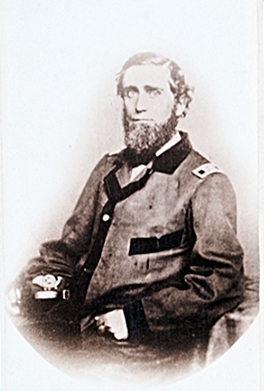William J. Landram facts for kids
Quick facts for kids
William Jennings Landram
|
|
|---|---|

Col. William J. Landram
|
|
| Born | February 11, 1828 Lancaster, Kentucky |
| Died | October 11, 1895 (aged 67) Lancaster, Kentucky |
| Place of burial |
Lancaster Cemetery
|
| Allegiance | United States of America Union |
| Service/ |
United States Army Union Army |
| Years of service | 1846–1847, 1861–1865 |
| Rank | |
| Unit | 1st Kentucky Volunteer Cavalry |
| Commands held | 19th Kentucky Infantry 2nd Bde / 1st Div / XIII Corps 2nd Bde / 10th Div / XIII Corps 4th Division, XIII Corps |
| Battles/wars | Mexican–American War |
William Jennings Landram (February 11, 1828 – October 11, 1895) was an important figure in American history. He was a lawyer and a newspaper publisher. During the American Civil War, he served as an officer in the Union Army. He was part of many important battles with the XIII Corps. Sometimes he led a large group of soldiers called a brigade, and sometimes even a division. His last name is also sometimes spelled Landrum.
Contents
Who Was William J. Landram?
William Jennings Landram was born on February 11, 1828, in Lancaster, Kentucky. He was the first of many children born to Louis Landram and Martha A. George.
His Early Life and Family
William's father, Louis, was a lawyer from Virginia. His mother, Martha, was from Garrard County, Kentucky. She was also the niece of George Robertson, a well-known politician and judge in Kentucky. William went to private schools in his local area. In 1845, he became a clerk for the courts in Garrard County. In 1849, he married Sarah A. Walker. They had nine children together.
His Time in the Mexican War
On June 9, 1846, William Landram joined the army. He became a private in the 1st Kentucky Cavalry during the Mexican–American War. He quickly moved up in rank to orderly sergeant. Landram fought bravely in the Battle of Buena Vista on February 22–23, 1847. During this battle, he was wounded in his shoulder by a saber. He left the army on June 8, 1847, and went back to his job in Lancaster.
His Political Career
From 1850 to 1851, Landram studied law. He also published a local newspaper called the Garrard Banner. This newspaper supported the Whig Party. In 1854, he became a lawyer. He was also elected as the Clerk of the Circuit Court for Garrard County. He kept this job until the Civil War started in 1861.
Landram strongly supported John Bell in the election of 1860. He believed in ending slavery and voted to abolish it in Kentucky in 1849. After the Whig Party ended, Landram joined the Republican Party.
William J. Landram in the Civil War
When the Civil War began, William Landram quickly joined the Union Army. He became a very important leader.
Joining the Union Army

On July 15, 1861, the War Department allowed General William "Bull" Nelson to set up a training camp. This camp was called Camp Dick Robinson. It was the first Union training center south of the Ohio River. Nelson made Landram a colonel in the 1st Kentucky Cavalry. However, Landram soon left that position. He wanted to lead infantry soldiers instead.
Later, Brig. Gen. William T. Sherman ordered Landram to Harrodsburg, Kentucky. There, Landram recruited soldiers for the 19th Kentucky Infantry. On December 12, 1861, he was elected as their colonel.
Important Battles and Commands
Landram was a skilled officer. He fought in many major battles. These included the Chickasaw Bayou, Arkansas Post, Champion Hill, and Black River Bridge. He also took part in the siege of Vicksburg and the siege of Jackson.
During the Red River Campaign, Landram was in command of a division. At the Battle of Sabine Crossroads on April 8, 1864, he was captured. However, he was quickly released and later exchanged for another soldier on July 22, 1864. On October 8, 1864, Landram was given command of the District of Baton Rouge. For his excellent service, he was promoted to brevet brigadier general on March 13, 1865. When the war ended, he returned home to Lancaster.
Later Life and Legacy
After the war, William Landram continued to serve his community.
Public Service and Family
In 1867, President Andrew Johnson appointed Landram as the Collector of Internal Revenue for the Eighth Kentucky District. President Ulysses S. Grant later reappointed him. He held this important job until 1885. Landram was also an elder in the Presbyterian Church for 42 years. He was a well-known member of the Freemasons.
In 1890, Landram applied for a disability pension. He wrote a letter explaining that he had gotten sick during the war. He said he had dysentery in April 1864, which caused ongoing health problems. He also mentioned that he did not own much property and relied on his law practice to support his family of six. William Jennings Landram passed away on October 11, 1895. He was buried in Lancaster Cemetery.

